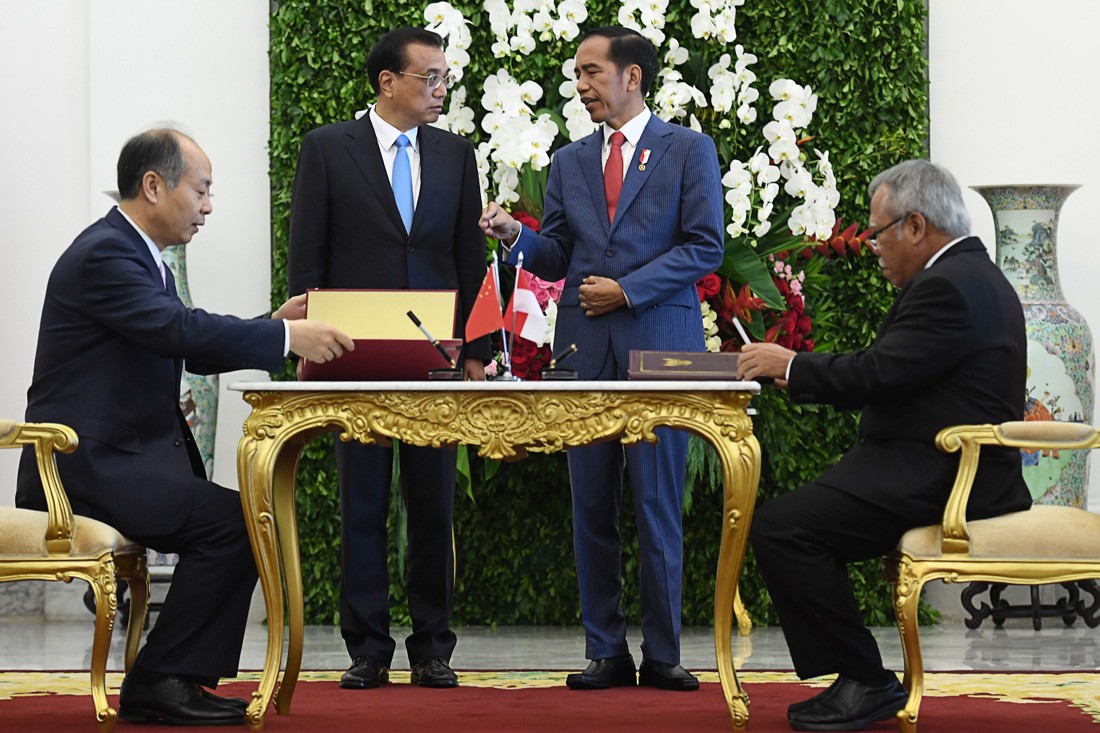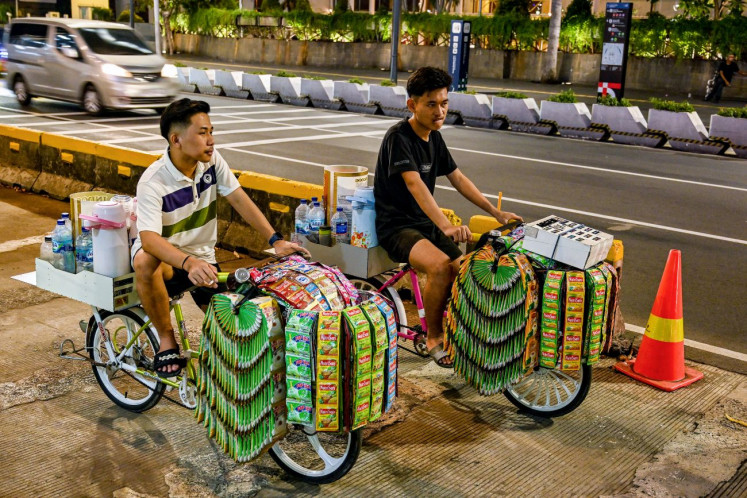Popular Reads
Top Results
Can't find what you're looking for?
View all search resultsPopular Reads
Top Results
Can't find what you're looking for?
View all search resultsCommentary: Time of reckoning on pace of Belt and Road Initiative
Indonesia stood to be the biggest beneficiary among the ASEAN economies, with more than US$87 billion identified in the BRI-related pipeline of infrastructure projects.
Change text size
Gift Premium Articles
to Anyone
 Closer ties: President Joko "Jokowi" Widodo (second right) and Chinese Prime Minister Li Keqiang (second left) witness the signing of an agreement on the review design of the Janelata and Riam Kiwa dam construction projects at the Bogor Palace in Bogor, West Java, on May 7. (Antara/Puspa Perwitasari)
Closer ties: President Joko "Jokowi" Widodo (second right) and Chinese Prime Minister Li Keqiang (second left) witness the signing of an agreement on the review design of the Janelata and Riam Kiwa dam construction projects at the Bogor Palace in Bogor, West Java, on May 7. (Antara/Puspa Perwitasari)
H
undreds of infrastructure projects worth hundreds of billions of dollars have been getting off the ground in Asian, European and African countries included in China’s Belt and Road Initiative (BRI), along with controversy, hurdles, delays and polarized public opinion in several countries.
Physical infrastructure, as the backbone of economic development, is critical to the success of the BRI agenda. But as a large number of Chinese enterprises seem to have rushed overseas, expanding their foothold across BRI-related countries, the process has not been smooth at all times.
Hence nearly five years after the BRI launch in late 2013, the third BRI summit here last Thursday was really the right time of reckoning, on the pace of the implementation of BRI projects. This reflection included contemplating why in several countries BRI projects have caused so widely polarized public opinion.
The BRI scheme has been designed by President Xi Jinping to build a network of overland road and rail routes, oil and natural gas pipelines, and other infrastructure projects that will stretch from central China, through Central Asia, Europe and Africa.
The BRI agenda certainly fits well with Indonesia’s top-priority development program to improve connectivity within the country and between the country and the global value chains.
A recent report by Baker & McKenzie consulting company concluded that from a geographic perspective, Indonesia stood to be the biggest beneficiary among the ASEAN economies, with more than US$87 billion identified in the BRI-related pipeline of infrastructure projects.
The Indonesian government itself has signed a $5 billion contract for the Jakarta-Bandung high-speed railway project under the BRI, and has been promoting special economic zones in North Sulawesi, North Kalimantan and North Sumatra for the BRI program.
But the main concerns raised about BRI project implementation in several South and Southeast Asian countries are related to the alleged lack of local worker participation and companies, the risk of unmanageable debts and the rather dominant geostrategic interest of China, rather than the economic viability and shared benefits, in several projects.
As most BRI projects are funded by long-term and very low-interest-rate loans from China’s state (policy) banks, most of the investment and construction also have understandably been made by Chinese companies.
Problems usually arise because many of these companies still lack work experience in foreign countries where they have to face a web of local and international laws, not to mention the full spectrum of political, security and economic risks.
Many speakers and analysts at the Hong Kong summit, including Suteja Sidarta Darmono, chief executive officer of PT Jababeka, which manages two of Indonesia’s largest industrial estates and two special economic zones, reiterated the strategic importance of tie-ups with local partners, local hiring and the procurement of local materials.
“Look for local companies with a good track record as they are the ones who know the local rules, business landscape, the local culture,” Darmono asserted in one of the sessions during the summit.
“Almost 90 percent of China-funded projects have been implemented by Chinese companies,” cautioned Shinta Widjaja Kamdani, vice president of the Indonesian Chamber of Commerce and Industry, in one of the plenary sessions.
This shows that in a more fundamental way, the biggest challenge is how China communicates its intentions and its vision for the BRI programs and reconciles its geostrategy with the interest of the host country of the projects, while it tries to flex its economic muscles as a regional and global power.
Fortunately, Hong Kong, seen as the super connector and most strategic gateway to mainland China, seems to have been aware of the start-up problems encountered in BRI projects in several countries.
One day before the summit, the Hong Kong Trade Development Council (HKTDC) initiated the establishment of a global alliance, the Belt and Road Global Forum, comprising over 110 chambers of commerce, industry associations, investment promotion agencies and think tanks from around 30 countries.
The forum will steadily admit new members from the BRI-related countries with the spirit of collaboration and openness in sharing experiences and views about infrastructure and business development.
Hong Kong has a significant role to play in the development and success of the BRI. The city is regarded among the world’s freest economies, with a vibrant capital market, and a regional logistics hub for sea and air cargo.
Earlier on June 20, according to China Daily, the All-China Journalists Association and around 100 journalists from 47 countries gathered in Beijing and set up the BRI Journalists Forum. This forum will be developed as a platform for mass media to nurture a better, comprehensive understanding of the BRI goals, through news sharing, mutual learning, policy studies and building bridges between cultures.
The BRI understandably still seems far away from being a coherent blueprint of interconnected international infrastructure investment. Infrastructure investment is very complex, involving strategy planning, technical assessment, feasibility studies, deal structuring, financial and tax planning, financing, project management and risk control.
The greatest benefit, though, is that physical connectivity could create a virtuous cycle to expand and deepen economic, social and cultural connectivity. The main challenges are identifying and designing the right projects, assessing the risks and then packaging projects in a way that ensures they are economically viable, beneficial, bankable and, most importantly, directly benefit the local people.
***
The writer is a senior editor at The Jakarta Post.










